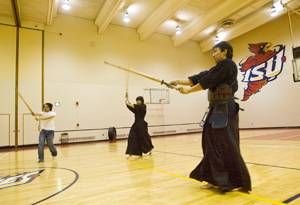Kumdo bring Korean martial arts to campus

ISU Kumdo Club practice October 30, 2008. Instructor: Daniel Joo, senior in architecture
November 6, 2008
Students are familiar with several forms of martial art, including Karate, Tae Kwon Do, Judo and Hapkido.
Not only does Iowa State have a club for each of these, but also one for Kumdo. Kumdo is a martial art with its origins in Korea — the Japanese version is called Kendo.
“‘Kum’ means sword and ‘do’ means journey, which together is the way of the sword,” said Daniel Joo, senior in architecture and president of Kumdo club.
In addition to practicing, the Kumdo club also goes to tournaments and has placed in many of them. This year, the team placed first at the Midwest Kendo Federation student tournament along with Joo placing first in the individual round. In addition, at the fourth U.S. Championship in Moline, IL this year, the team placed second in the team rounds.
Kumdo is similar to the Western sport of fencing. It requires a sword made of bamboo, called “jukdo” in Korean and “shinai” in Japanese and armor is required to protect oneself.
The practices end with sparring, and although sparring can be fun, a concern associated with it is getting injured.
Phil Schmidt, senior in industrial engineering, has been in Kumdo for a year. Schmidt’s roommate first introduced him to the sport when he needed something to do in his free time.
“Kumdo is actually a very safe sport,” Schmidt said. “Kumdo requires full armor.”
Although in ancient times, Kumdo was used for fighting purposes, today it serves a completely different purpose.
“Today Kumdo is not practical for fighting,” Joo said, “but it is even more pure today because we use it mainly for discipline,” he said.
One main goal is to achieve Ki Kum Che, which means synchronizing spirit, body and sword to make perfect strikes. To attain Ki Kum Che, an ordinary practice includes basic stretching for warm-ups, basic hitting for practicing good form, base hitting for good body movements and good timing, said Jyoshu Tsushima, senior in political science.
“Kumdo requires patience, self-discipline, and being able to self-reflect,” Tsushima said. He placed second in individual rounds of the Championship in Illinois.
The ISU Kumdo club was founded by Joo’s father more than 10 years ago. Joo has been involved since he was 12 years old.
“I didn’t have a choice — it was something my dad made me do,” Joo said.
Fortunately, Joo started to enjoy the sport and began to take lessons from practicing.
“It’s like reading the same book over and over again,” Joo said. “You will always find new things.”
ISU Kumdo Club
When: 6:30-9 p.m. Tuesdays and Thursdays
Where: Forker Gym
Notes: Don’t worry if you’re a new member without a practice sword because one will be provided. Please bring clothes that you will be able to practice in comfortably and flexibly. Dues are not required until after your first meeting.
















